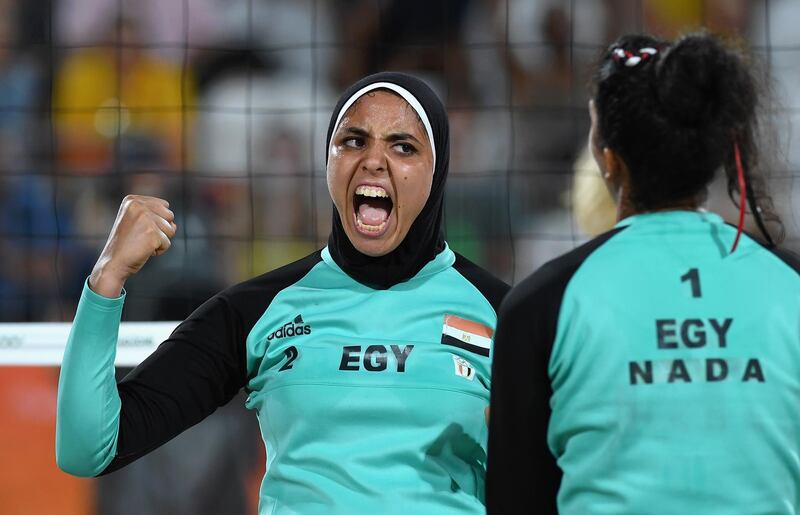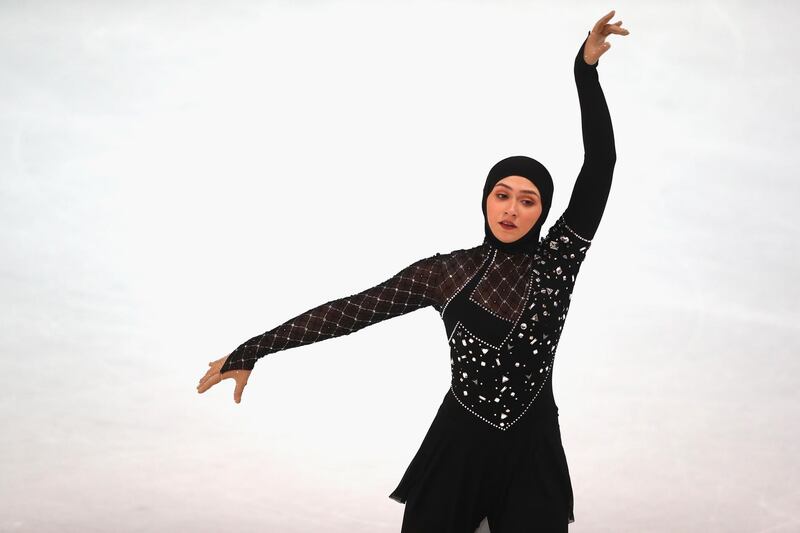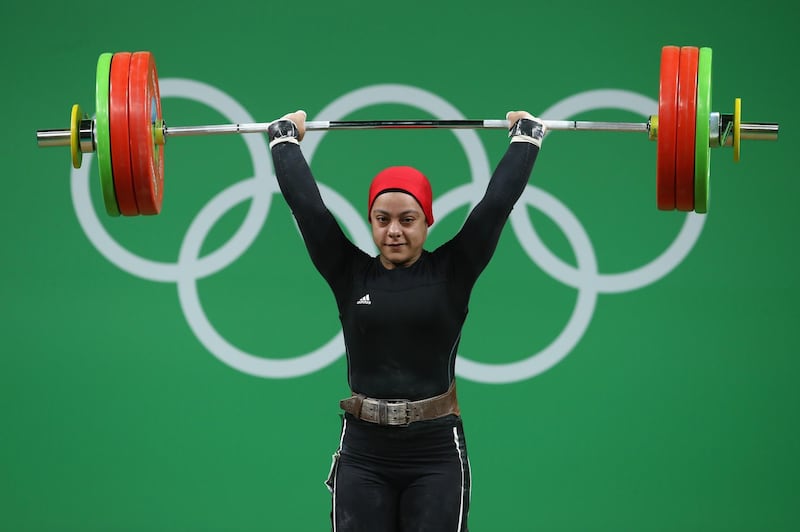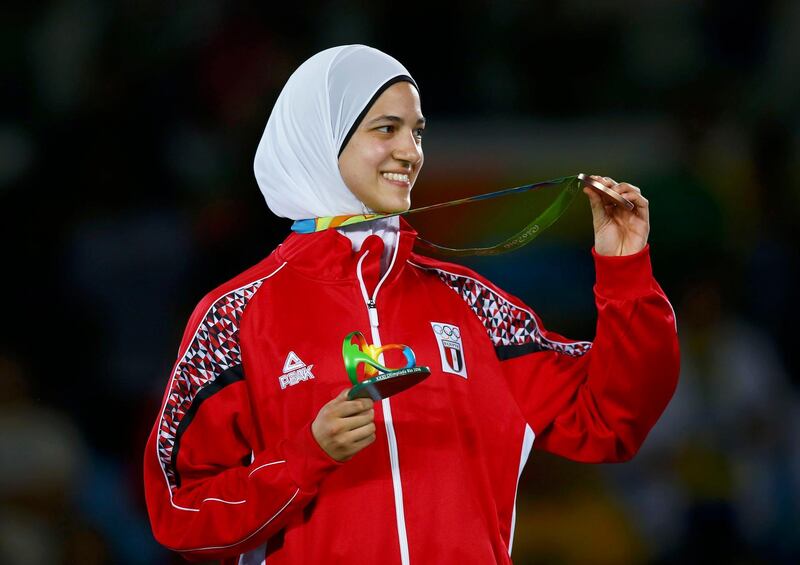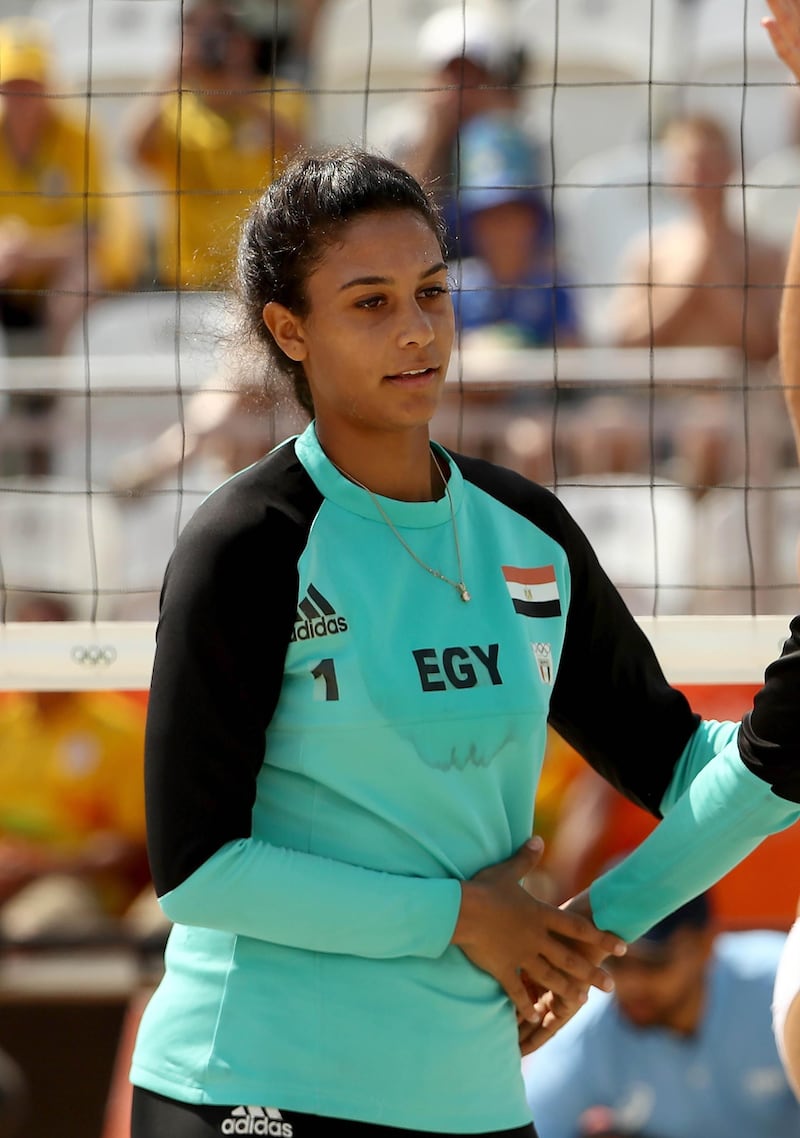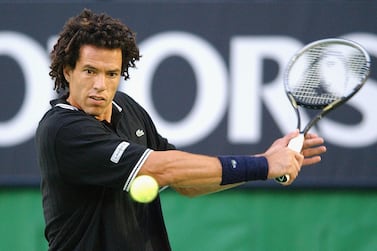A day after her opening beach volleyball match against Germany at the Rio 2016 Games, Egyptian Doaa Elghobashy was walking around the Olympic Village getting attention like she was Usain Bolt.
An action shot of Elghobashy, wearing a hijab, a long-sleeved shirt and full-length leggings, and coming face-to-face with her bikini-clad German opponent Kira Walkenhorst at the net, went viral and remains one of the most iconic images to come out of Rio de Janeiro that summer.
A single frame symbolised the union of cultures one has come to expect from the Olympic Games, yet the monumental reaction it received made it seem like such differences on display at the international stage were somehow still a novelty.
"So many people came up to me to say hello, just because they saw my photo. I suddenly found myself famous around the Village and I had no idea why; turns out it's just because I compete in beach volleyball while wearing a hijab," Elghobashy told The National.
In her second match, alongside her team-mate Nada Meawad, against Italy, Elghobashy played in front of a sell-out crowd of 10,000 people at the Copacabana beach.
“People came to check out who is this Doaa Elghobashy who is competing with the hijab and has her photos all over the internet,” she recalls. “We lost the match and we still got a standing ovation and people were chanting ‘Egito, Egito’ [Egypt in Portuguese]. People were very happy with what we were able to achieve.”
Elghobashy and Meawad made history that week in Rio, as the first-ever Egyptian duo to compete in beach volleyball at an Olympic Games. But it was Elghobashy’s outfit that thrust her into the spotlight. She had been wearing the hijab and doing sports for 10 years, but needed to get special approval for her match kit before Rio, in order to make sure they would let her play.
“The whole thing was new to me – to be the first hijabi player competing in beach volleyball, and to be the first Egyptian and Arab woman to make it to the Olympics in this sport. So for me, it was a challenge that was much bigger than just the hijab. I wanted to be the first person to do this. It was special,” says the 23-year-old Elghobashy.
“Since then, I’ve been able to compete in international championships with the hijab without any problems.”
Elghobashy explains how the international volleyball federation (FIVB) now has three approved attire options, with varying degrees of covering up, that allow her to compete in conservative wear.
Originally an indoor volleyball player since the age of seven, she only took up beach volleyball in 2014. Elghobashy still competes in both disciplines but says beach volleyball witnessed a huge surge in popularity and participation after her Olympic debut with Meawad. Courts were installed across Egypt, and scores of women switched from indoor volleyball to beach volleyball.
“We used to go for training camps at a public beach in Port Said, now we have more facilities. I also have become a certified level one beach volleyball coach,” she added. “Beach volleyball has become a genuine option for our players.”
It’s amazing what can happen when a sport decides to become more inclusive and gives young women the chance to see people who look like them and dress like them competing at the highest level.
Egypt’s two female medallists in Rio 2016, Hedaya Malak (taekwondo) and Sara Ahmed (weightlifting), both wear the hijab. Malak, who won bronze in the -57kg weight class, was overwhelmed by the support she got as a result.
"A lot of people messaged me after the Olympics telling me, 'You're my idol because you're wearing the hijab and are playing your sport'. That I didn't take off the hijab for taekwondo. I felt that a lot of people were inspired," Malak told The National.
“Abroad, people always ask me, ‘Wow, how do you train in this heat while wearing this? We’re wearing short sleeves and shorts, and you’re wearing long sleeves and a scarf and you’re not feeling hot or anything’. They would always ask me stuff like that but now they got used to it.”
One of the reasons hijabi athletes are still viewed as an uncommon phenomenon internationally is that several sports spent years trying to stop them from competing.
Fifa, football’s international governing body, overturned its ban on hijab as recently as 2014, while FIBA, basketball’s governing body, lifted its ban on headgear in 2017, thanks to the efforts of Bilqis Abdul-Qaadir, a Muslim-American collegiate basketball player who was forced to make a choice between her faith and her sport, and spent years campaigning against the ban.
Many athletes still require special waivers to compete in the hijab and the language of attire rules in various sports can be vague and misinterpreted by officials.
Elghobashy recalls how several of her basketball-playing friends could not be part of the national team just because they wore the hijab.
“If you want to have a truly competitive sport, you have to open the door to everyone, be it hijabis or non-hijabis,” she says. “Let’s say we have a very talented hijabi athlete, is it fair that she cannot compete just because she is covering up? I always say, do not let a hijabi athlete hate her own hijab just because she cannot do something she wants to do or play the sport she loves. Give everyone their space to dress the way they want so they can showcase their talents, instead of forcing them to do something they do not believe in and do not accept.
“Why kill someone’s dream just because they wear the hijab and the sport doesn’t allow that?
“At the end of the day, each one of us comes from a different culture and we all deserve to be accepted.”
Emirati Zahra Lari is the first hijabi figure skater to compete internationally and she had to contact the International Skating Union (ISU) to discuss the sport’s attire rule after she was deducted points by judges for her conservative outfit in her first event abroad back in 2012.
She still receives special waivers to perform in the hijab since the wording of rule 501 in the ISU’s regulations guide does not explicitly address religious headwear.
Noor Ahmed, an American college golfer born in Sacramento to Egyptian parents, describes her experience as a hijabi student-athlete at the University of Nebraska-Lincoln.
"I feel like every time I step onto a golf course I have to prove that a Muslim woman can compete and compete in a hijab and compete well," she told Golfdigest.com.
“On the golf course, the hijab makes me stand out. It’s definitely a reminder every time I step on the golf course that I am different. No one will look like me. No one will dress like me. Every time you’re stepping onto the course is helping break down stereotypes.”
Tennis is a sport that hasn’t always been welcoming to hijabis or women who preferred to dress conservatively. The WTA and ITF’s rulebook had an attire regulation that stated women could only wear leggings that were mid-calf length (a hijabi woman typically needs to cover the full length of her legs) and could only wear them under a skirt or a dress.
That rule changed last year, and players can now wear leggings without a skirt or dress on top, and any details regarding the length of leggings have been removed from the rulebook. There is no specific mention of the hijab but tennis players generally do not have restrictions on headgear.
It had never occurred to tennis authorities that the old rule dismissed an entire group of women who may have wanted to pursue a professional tennis career while covering up.
The previous versions of the rule gave room for misinterpretation by umpires. Fatma Al Nabhani, an Omani tennis player who chooses to dress conservatively while competing, complained to the ITF more than once about officials who demanded she take off her leggings before her matches, despite them being of the approved length.
She recounts a time when a French umpire at a tournament in Tunisia asked her if she was wearing her leggings because of her religion or because of the cold weather. “If it’s because of your religion then you need to take it off,” the umpire said, according to Al Nabhani.
I once posted on Twitter a photo of hijabi tennis player Dona Abohabaga playing a Fed Cup match for Egypt in Cairo in 2016 and received a slew of messages online, ranging from shock to sarcasm to disdain. That’s how unheard of hijab is in the world of tennis.
Muslim women have come a long way in the world of sport. Athletes like Abdul-Qaadir, Ibtihaj Muhammad, Elghobashy, everyone mentioned above and many more, have played a crucial role in breaking barriers, changing perceptions, and paving the way for others to follow suit.
International governing bodies must continue to make sure they are doing their part in creating an inclusive and welcoming environment for all. They shouldn’t wait until a Muslim player rises through the ranks and requires an exception to pursue her dream while respecting her faith.
Who knows, maybe one day a hijabi athlete will be acknowledged for her accomplishments first, before any mention of her faith or what she chooses to put on her head.
